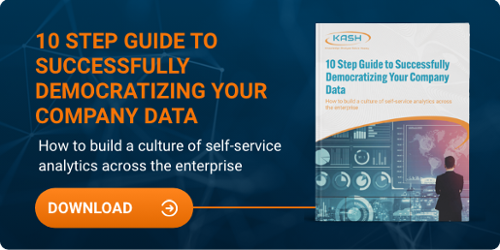How to Effectively Deploy a Self-Service Analytics Business Intelligence Strategy
Topic:
Democratizing Data
Deploying self-service business intelligence (BI) and data analytics sounds like a winning strategy for everyone. It democratizes data to empower frontline employees with the information they need to make better decisions while reducing the burden on the IT staff.
So why do so many self-service data analytics implementations fail? Despite powerful tools, companies often struggle to deliver on self-service analytics. According to an Accenture survey, only 27% of business executives say their data analytics project yields actional insights.
What is Self-Service Analytics?
Self-service analytics is a business intelligence model that enables frontline employees to access and analyze data without requiring support from IT teams or data scientists. This could also mean users are trained to learn how to create information using the developer’s tool set. Successful deployment of self-service analytics puts the power of analytics into the hands of all users including executives, managers, and front-line workers within the company. We call this ‘analytics for the masses.’
Without self-service analytics applications, users are generally forced to call on IT and data teams to request the data they need, or have data marts/stores created for them that address their specific needs. This creates a burden on IT and adds to the backlog of requests. True Self-service analytics enables end-users to address their analytics and data needs themselves. Often, this leads to deeper insights and better decisions by a much larger number of users throughout the organization.
3 Common Challenges to Avoid When Implementing a Self-Service Analytics BI Strategy
The amount of data being collected and stored today is staggering. In 2021, more than 1.134 trillion MB of data was created every day. The rollout of 5G, IoT, and IIoT devices is only adding to this mass amount of data.
Despite this wealth of information, 97% of the data gathered goes unused.
Often, companies struggle because they focus their research on a specific tool, use a limited set of data, and then implement a solution with little or no involvement by the business users. As such, these implementations tend not to be well suited to the end users. A better approach is to first, focus on understanding their users' needs and then work backward to the data. Without organizational alignment of goals among the business, adoption is oftentimes limited to a small group of power users. In the long run, this can create an unnecessary burden on IT resources. In both examples, companies may never leverage the true power of the data they gather.
1. IT Data Analytics Burden
All data analytics solutions will require the involvement of IT staff. They are critical to providing access rights to the various data sources, building visualizations, dashboards, and widgets on the data, or even building out complete analytical applications to be used by the rest of the organization.
Taking a more strategic approach to self-service Business Intelligence can significantly reduce the burden on IT teams to let them focus on what they do best. This is especially important in today’s tight labor market, where nearly every company is struggling to recruit or retain IT, staff.
If your data analytics strategy is built around a handful of people, amid a shortage of skilled IT staff, it can quickly become problematic. This is one reason why self-service analytics offer so much potential. By reducing the burden on IT teams and data scientists and allowing end-users to do their own analytics discovery, you create a more data-centric organization.
2. Data Literacy
The biggest challenge with realizing the full ROI potential of self-service data analytics is caused by low user adoption. If only a small portion of an enterprise uses the BI tools, you will not realize the potential value.
Another of the key causes of low adoption rates is the lack of data literacy. Nearly three-quarters of employees say they feel overwhelmed working with data inside the company.
While 83% of business leaders expect all employees to have the basic data literacy skills they need to do their job, just 40% of employees said they have the skills or receive the training they need. When employees aren’t confident in their data literacy, they often lack confidence in the data itself — especially if they are using self-service tools.
Increasing adoption rates requires sufficient training to ensure employees can navigate data platforms and trust the results they get.
3. Data Access Outside the Organization
Another challenge with self-service analytics is when companies need access outside the organization or want to create data for external groups or users. With today’s distributed, remote, and hybrid workforce, this has become an increasing challenge.
How to Successfully Deploy A Self-Service Analytics Strategy
Overcoming these challenges and deploying a successful self-service data analytics platform requires a thoughtful and strategic approach.
Get Top-Level Buy-In
Adopting a self-service analytics culture is a long-term business commitment. Data usage and adoption are driven by corporate culture, which emanates from a company’s top executives. We’ve all seen great tools that get rolled out in companies but fail to be used because of a lack of management support.
Without this support and commitment, it’s too easy for end-users to ignore.
Align Key Stakeholders
It’s also crucial that you get alignment with the key stakeholders across different business units. You should identify the key internal departments that will benefit the most from clear data insights and make sure you design your system to help them achieve their goals.
This requires serious discussions about data needs and goals, focusing on business priorities before tech features. Business priorities should always take precedence.
As part of this process, you will also want to establish who is responsible for what, so employees have a clear understanding of use cases. Many organizations create internal service level agreements (SLAs) to document the level of service IT teams and data scientists will provide to business users. This helps formalize the expectations of all users.
Create a Single Application Experience
While IT teams must architect a robust infrastructure for enterprise-wide data access, end-users require only access to the data that is required by their position within the organization. By separating the data layers from applications, you can eliminate creating data silos for different groups of users and ensure everyone is working off the same data to create a single source of truth.
End users don’t care where or how data is stored as long as they can access it. Creating a single application experience where users can access prepared data also helps reduce dependency on the IT team for support.
Employ Strong Data Governance
Without strong data governance, self-service data analytics will fail. The guidelines for data practices and processes are essential to creating trust.
While it may seem obvious that data governance is a foundational element for organizations, strong governance is not universally widely adopted. When there’s trust in the data, end-users will learn to trust the results they get back from the analytics solution put into place.
While data should empower workers with insights to make better decisions, an Accenture study reported that only 37% of employees trust their decisions at a higher level when accessing data. This is a major reason why so many users often copy the data into their own spreadsheets for ongoing reporting and analysis.
Build a Comprehensive Self-Service Analytics Training Program
End-users must also be comfortable using the self-service tools you provide. While the underlying infrastructure and architecture may be complex and pull data from multiple sources, the analytics application itself must be intuitive and easy to use.
Still, organizations need to invest in significant and ongoing training to ensure users adopt self-service data analytics.
Conclusion
Businesses need to treat their internal business analytics projects like they treat any new product they are building for the market they serve. A poor product means low adoption.
A strategic business initiative with support from the top of the organization, a commitment to use self-service analytics tools, and an understanding of expectations, play an important role in adoption. Just like any other business plan, there should be clear goals developed with team members knowing how success will be measured.
To discover how you can take the first steps to create an impactful data strategy for your business, download the eBook, "10 Step Guide to Successfully Democratizing Your Company Data."
